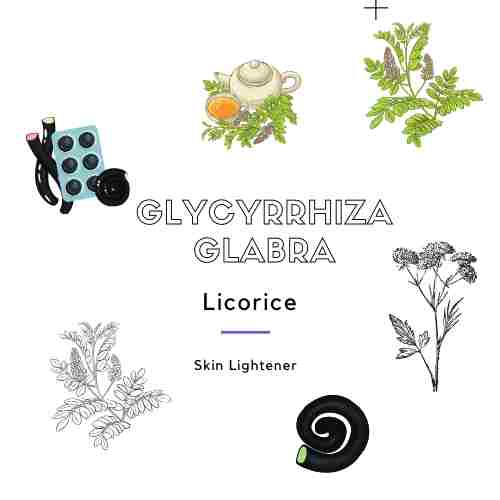When you and I think of licorice, we think of sweets. Like me you may really hate the flavour of licorice, but after reading today’s blog you may start to look for it in your skincare products.
Glycyrrhiza glabra (licorice) extract comes from a leguminous plant and grows in Asia as well as Europe. Like Aloe Vera, Licorice contains a bunch of compounds, including GLABRIDIN and LIQUIRITIN. Glabridin is a skin lightener (see below).++
Functions of Licorice extract include:
- tightening and firming of the skin
- potent anti-oxidant activity
- anti-inflammatory activity
- inhibit the rate limiting action of the enzyme, Tyrosinase and therefore is a skin lightener.
Glabridin and Melanogenesis
The compound Glabridin is one of the main components of licorice extract. Yokota et al investigated the impact of Glabridin on melanogenesis using B16 murine melanoma cells (this is an accepted model used to quantify (e.g.) the reduction in tyrosinase activity). They found that glabridin inhibits the tyrosinase activity of these cells at concentrations of 1.0 μg/mL without affecting DNA synthesis.
Liquiritin and melasma
In a study involving 20 women with melasma, they were treated with topical liquiritin cream with instructions to avoid the sun / use sunscreen.
The clinical trial demonstrated that topical liquiritin cream at 1g/day for 4 weeks produced phenomenal results. Good to excellent results with complete disappearance of melasma were observed in 18 of the 20 women at week 3. Side effects were reported to be minimal with mild irritation that disappeared after the continuation of the treatment.
However, interestingly, Liquiritin has been found not to inhibit the mushroom tyrosinase, which okay is not the same as human tyrosinase..
Closing
Glycyrrhiza glabra (licorice) extract is one of the safest skin lightening agents, with few side effects. When you find it in a product, its likely that the licorice extract is essentially Glabridin and not Liquiritin.
The likely reason why the Ordinary or any other pharmaceutical giant has not bottled it up for individual sale is likely to do with cost and the fact that, “the principal disadvantages of Glabridin are its insufficient skin-entering capacity and its instability in a formulation.”
Sources and uses
Amer M et al, Clinical Trial: Topical liquiritin improves melasma International Journal of Dermatology 2000 39, 299-301
Yokota T et al. The inhibitory effect of glabridin from licorice extracts on melanogenesis and inflammation. Pigment Cell Res 1998; 11: 355–61.
Liquorice (Glycyrrhiza glabra): A phytochemical and pharmacological review
Solano, F., Briganti, S., Picardo, M., & Ghanem, G. (2006). Hypopigmenting agents: An updated review on biological, chemical and clinical aspects. Pigment Cell Research, 19(6), 550–571.
Ebanks, J. P., Wickett, R. R., & Boissy, R. E. (2009). Mechanisms regulating skin pigmentation: The rise and fall of complexion coloration. International Journal of Molecular Sciences, 10(9), 4066–4087.
Draelos, Z. Skin lightening preparations and the hydroquinone controversy. Dermatol. Ther. 2007, 20, 308-313
